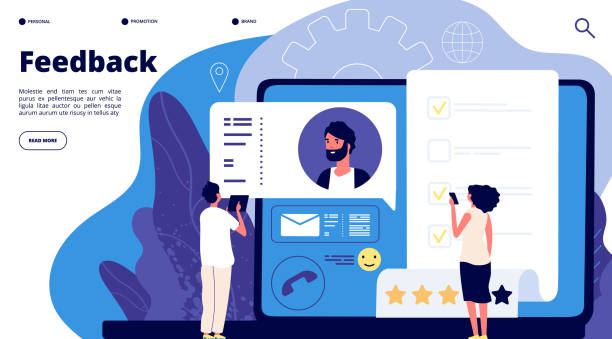Introduction to the Necessity of Responsive Web Design in Today’s World

In the current digital age, where #various_devices are used to access the internet, including smartphones, tablets, laptops, and even smart TVs, the need for a flexible #web_design is felt more than ever.
Responsive Web Design is an approach that ensures your website is displayed correctly and provides a flawless experience, regardless of the screen size or type of device the user is employing.
This approach is not limited to visual aesthetics; it directly impacts #site_performance, loading speed, and ultimately, the satisfaction of both #mobile_and_desktop_users.
Optimizing a website for every device not only increases accessibility but also plays a vital role in Search Engine Optimization (SEO).
Responsive websites are preferred by search engines like Google because they have a single URL for all devices, making content and link management easier.
Ignoring this can lead to losing a large segment of your audience and business opportunities.
This chapter provides a comprehensive explanation of this concept and its importance in the modern web ecosystem, laying the groundwork for more specialized topics in subsequent chapters.
This concept is particularly vital in today’s competitive market, where users expect a fast and hassle-free user experience, significantly contributing to the success of online businesses.
Did you know that a poor corporate website costs you many opportunities daily? Solve this problem forever with a professional corporate website design by Rasawp!
✅ Create a powerful and reliable image for your brand
✅ Attract targeted new customers and increase sales
⚡ [Get Free Website Design Consultation]
Why is Responsive Web Design Crucial for SEO and User Experience?

The role of responsive web design in improving SEO and UX is undeniable.
Search engines, especially Google, rank mobile-optimized websites higher in search results.
This prioritization began in 2015 with “Mobile-Friendly Update” Google and became a standard with the introduction of “Mobile-First Indexing” in 2018.
Having a responsive website means your content is easily accessible and readable on any device, which directly impacts the reduction of Bounce Rate and an increase in Dwell Time.
When users have a good experience on your site, they are more likely to return and become loyal customers.
Furthermore, managing a single website for all devices significantly simplifies content maintenance and updates.
This prevents the creation of separate mobile and desktop versions, reducing human error and data redundancy.
Additionally, site loading speed, a crucial factor in SEO ranking and user experience, is carefully considered in responsive design.
Using optimized images and efficient code ensures that your site loads quickly on all devices.
This comprehensive approach not only helps your site gain more visibility in search results but also turns your visitors into satisfied and loyal customers.
Therefore, investing in responsive web design means investing in the future of your online business, as without it, competing in the digital market will be extremely difficult.
Core Technologies and Principles of Responsive Web Design

Implementing responsive web design relies on a set of fundamental technologies and principles that enable a website to adapt to different screen sizes.
One of the most important of these technologies is “Media Queries” in CSS3.
Media Queries allow web designers to apply different CSS rules based on device characteristics, such as screen width, height, orientation, and resolution.
For example, different CSS can be defined for displaying the website on smartphones (with narrow width) and desktops (with wide width).
Another principle is the use of “Fluid Grids.”
Instead of using fixed pixel widths, relative units like percentages are used to define element widths.
This means that page elements automatically adjust their size to the available space, contracting or expanding instead of breaking the layout.
Fluid Images are also a crucial part of this approach; by using properties like `max-width: 100%` in CSS, images can automatically resize without losing quality or disrupting the layout.
Flexible Typography, using relative units like `em` or `rem` for font sizes, ensures that text is readable on all devices.
Finally, the “Mobile-First” approach is a philosophical principle where design starts from the smallest screen, i.e., mobile, and then progressively develops for larger screens.
This approach ensures that the core content and functionality are optimized first for mobile users, who often constitute the largest portion of web traffic.
The table below lists some of the most common Breakpoints in Media Queries that developers use to adapt the design to different devices:
| Device Name/Size | Approximate Width (pixels) | Media Query Type | Common Use |
|---|---|---|---|
| Smartphone (small) | Up to 320px | @media screen and (max-width: 320px) |
Design for smallest screens, essential content |
| Smartphone (standard) | 321px to 480px | @media screen and (min-width: 321px) and (max-width: 480px) |
General mobile design, dropdown menus |
| Tablet (portrait) | 481px to 768px | @media screen and (min-width: 481px) and (max-width: 768px) |
Two-column layout, increased font size |
| Tablet (landscape) and small laptop | 769px to 1024px | @media screen and (min-width: 769px) and (max-width: 1024px) |
Three-column layout, more complete navigation |
| Laptop and Desktop | 1025px and above | @media screen and (min-width: 1025px) |
Full desktop layouts, display more details |
These principles and technologies help developers create websites that not only perform better but also provide a positive user experience across all platforms.
Responsive web design has evolved over time and has now become a requirement in the web industry.
The Mobile-First Approach and Its Importance in Responsive Web Design

The “Mobile-First” concept is one of the fundamental and vital principles in responsive web design, considered not just a technical technique but a design philosophy.
In this approach, the website design and development process begins with the smallest screens, i.e., smartphones.
Instead of designing for desktop first and then trying to condense it for mobile, designers first address the needs and limitations of mobile devices.
This means prioritizing essential content and functionalities, as screen real estate on mobile is limited, and every element must be purposeful.
This approach ensures an optimized user experience on mobile devices, which is crucial given the growing statistics of mobile internet access.
The benefits of this approach include improved site performance (as unnecessary desktop code is not loaded initially), focus on core content, prevention of clutter, and ultimately, improved SEO.
Google increasingly uses Mobile-First Indexing, meaning it considers your website’s mobile version as the primary version for indexing and ranking.
Therefore, if your website is not optimized for mobile, it may suffer in search results.
Implementing the mobile-first approach also helps design and development teams address performance and accessibility issues from the outset, preventing complex problem-solving in later stages of the project.
This method is considered a strong competitive advantage because it ensures your website is not only visually appealing but also fully functional and fast on any device.
This approach has made responsive web design an industry standard and a necessity for any business seeking online success.
Are you losing business opportunities because of an outdated website? With Rasawp, solve the problem of not attracting potential customers through your website forever!
✅ Attract more high-quality leads
✅ Increase brand credibility in the eyes of customers
⚡ Get Free Corporate Website Design Consultation
Common Challenges in Implementing Responsive Web Design

Despite the numerous advantages of responsive web design, its implementation is not without challenges.
One of the biggest challenges is managing design complexities.
Creating layouts that look good and function properly across a wide range of screen sizes requires skill and careful planning.
Sometimes, what looks great on desktop becomes cluttered or unusable on mobile.
Another challenge is image optimization and other media.
High-quality images are great for large screens but can significantly slow down website loading on mobile devices.
Developers must use techniques such as “Responsive Images” or “Lazy Loading” to ensure that images are only loaded in the size and quality necessary for the user’s device.
Site performance is also a significant challenge; CSS and JavaScript codes written for desktop might be heavy on mobile and increase loading times.
This requires precise code optimization and the use of compression tools.
Testing and debugging responsive websites across different devices and browsers are also time-consuming and complex.
Since there are countless device/browser combinations, ensuring correct functionality on all of them is a difficult task.
Furthermore, website content must be designed to be well-viewable and readable across different screen sizes.
This might mean revisiting content structure and prioritizing information.
However, with proper planning, the use of modern frameworks, and optimization techniques, these challenges can be overcome to create an efficient and effective responsive web design.
Tools and Frameworks for Responsive Web Design Development

To simplify the implementation process of responsive web design, developers can utilize a set of tools and frameworks.
These tools not only accelerate development speed but also help maintain code consistency and quality.
One of the most popular CSS frameworks is Bootstrap.
Bootstrap offers a comprehensive collection of pre-written CSS and JavaScript, including flexible grid systems, UI components (such as buttons, forms, navigation bars), and JavaScript plugins.
This framework enables developers to quickly build modern and responsive websites.
Tailwind CSS takes a different approach; it’s a “Utility-First” framework that provides a set of helper CSS classes instead of ready-made components.
This approach gives developers more flexibility in design and prevents CSS bloat.
In addition to CSS frameworks, other tools exist for testing and debugging.
Chrome browser’s DevTools includes a “Device Mode” feature that allows developers to simulate the website on various screen sizes and check its performance.
PageSpeed Insights and Lighthouse tools from Google also help evaluate performance, accessibility, and SEO best practices.
For managing responsive images, tools like Imgix or Cloudinary offer image optimization services that automatically resize and format images based on the user’s device.
Using Sass (Syntactically Awesome Style Sheets) or Less, CSS preprocessors, can also help organize and manage CSS code in large projects.
Ultimately, by leveraging these tools and frameworks, the development of responsive web design becomes a more efficient and enjoyable process.
The Future of Responsive Web Design and Evolving Trends

The world of web is constantly changing, and responsive web design is no exception.
The future of this field will see evolution and integration with new technologies.
One significant trend is the increasing use of Progressive Web Apps (PWAs).
PWAs are websites that can offer a user experience similar to native apps, including offline functionality, Push notifications, and the ability to install them on the device’s home screen.
This combination of web power and responsive design flexibility opens up new horizons.
Furthermore, the emergence of new devices such as smartwatches, foldable displays, and virtual/augmented reality creates new challenges and opportunities for responsive design.
Designers must be able to deliver experiences that go beyond traditional screen sizes.
The role of Artificial Intelligence (AI) and Machine Learning (ML) in optimizing design and user experience is also growing.
AI can automatically adjust layouts based on user behavior and device type, or provide personalized content.
This contributes to increased efficiency and personalization in responsive web design.
The concept of “Container Queries,” currently under development, will also be a significant step in the evolution of responsive design.
Instead of merely reacting to the viewport width, elements can respond based on their parent container’s width, providing greater flexibility in component design.
Finally, focusing on Accessibility and embedding it into the core of responsive web design is also of high importance.
Websites must be accessible to all users, including individuals with disabilities.
The table below illustrates some emerging trends in web design that contribute to the evolution of responsive design:
| Emerging Trend | Description | Impact on Responsive Web Design |
|---|---|---|
| Progressive Web Apps (PWAs) | Native app-like website experience, offline capability, notifications | Increased user engagement and retention across all devices, better performance |
| Container Queries | Elements respond based on parent container, not just Viewport | More flexibility in independent components, reusability |
| Design for Foldable and Flexible Devices | Emergence of phones and tablets with flexible displays | Need for layouts that change between folded/unfolded states |
| Advanced Micro-Interactions | Small animations and feedback to improve user experience | Increased attractiveness and dynamism in interacting with responsive elements |
| AI-Powered Design | Automatic optimization of layout and content based on user data | More personalization and performance optimization based on actual behavior |
| Focus on Accessibility | Design incorporating accessibility principles for all users, including those with disabilities | Websites that are usable by a wider range of audiences |
These trends indicate that responsive web design is not just a static concept but a dynamic approach that evolves with technology and user needs.
Best Practices for Optimizing Responsive Website Performance

Creating a responsive website design is only the beginning; optimizing its performance is equally important.
A slow-loading responsive website can severely degrade the user experience and negatively impact SEO.
One of the best practices is image optimization.
Using modern image formats like WebP, compressing images without losing quality, and implementing Lazy Loading for off-screen images can significantly reduce initial page load time.
Lazy Loading ensures that images are only loaded when the user scrolls near them.
Minification and compression of CSS, JavaScript, and HTML files are also crucial steps.
These processes remove whitespace, comments, and unnecessary characters from files, reducing their size, which leads to faster loading.
Using a CDN (Content Delivery Network) to serve static files can also help improve global performance, as content is delivered from the server closest to the user.
Client-side Caching also ensures that the user’s browser stores some files, so they don’t need to be re-downloaded on subsequent visits.
Critical CSS is a technique where the necessary CSS for rendering the first visible content on the page (Above the Fold) is inlined in the HTML.
This allows the user to see the main content sooner, even before external CSS files are fully loaded.
Avoiding excessive redirects, reducing HTTP requests, and optimizing JavaScript code to run in the background or asynchronously also contribute to performance improvement.
These combined actions ensure that responsive web design is not only beautiful and adaptable but also provides a fast and smooth experience for users on any device.
Did you know that a poor corporate website costs you many opportunities daily? Solve this problem forever with a professional corporate website design by Rasawp!
✅ Create a powerful and reliable image for your brand
✅ Attract targeted new customers and increase sales
⚡ [Get Free Website Design Consultation]
Case Studies and Success Stories in Responsive Web Design

Examining successful examples of responsive web design can be inspiring and demonstrate how this approach can lead to tangible business results.
Many leading global brands have achieved significant success by adopting and correctly implementing responsive design.
For instance, Starbucks saw a substantial improvement in its mobile user experience by redesigning its website to be responsive.
This change not only allowed users to easily browse the menu and find the nearest branch but also increased customer engagement and loyalty.
Microsoft‘s website is another prominent example of responsive web design that effectively uses Grid Layout and Media Queries to provide a consistent experience across various devices, from large monitors to tablets and smartphones.
This adaptability is crucial for a technology company whose products are used in diverse ecosystems.
Another success story belongs to Google Search, which itself strongly focuses on being mobile-first.
This focus has helped Google maintain its position as the top search engine, as the majority of searches today are conducted via mobile devices, and an optimal user experience on these devices is of paramount importance to Google.
BBC News also used responsive web design to make its news content accessible to a wide audience worldwide and on any device.
This helped them quickly adapt to changing media consumption habits and retain their audience.
These case studies show that responsive web design is not merely a trend but a proven business strategy that can lead to increased traffic, improved conversion rates, and stronger branding.
This approach is vital not only for large corporations but also for small and medium-sized businesses to be competitive in today’s digital market.
The Impact of Responsive Web Design on Brand Experience and Customer Loyalty

Beyond improving SEO and technical performance, responsive web design plays a crucial role in shaping brand experience and building customer loyalty.
In today’s world, your website is often the first point of contact many customers have with your brand.
If this initial experience is disappointing – for example, if the site is cluttered on mobile, navigation is difficult, or loading is slow – the likelihood of the user leaving the website and not returning is very high.
Conversely, a responsive web design that is fluid and pleasant across all devices conveys a sense of professionalism and attention to detail to the user.
This subconsciously increases user trust in your brand.
When users can easily access your content and products without worrying about zooming, horizontal scrolling, or unreadable forms, a positive experience is formed.
This positive experience builds a foundation for customer loyalty.
Customers remain loyal to brands that understand their needs and provide convenient and efficient solutions.
Responsive web design does exactly that.
This also contributes to Brand Consistency.
By having a single website that appears consistently across all platforms, your brand message is communicated continuously and without alteration, which itself helps strengthen brand identity.
Finally, in the age of social sharing, a positive user experience on a responsive site increases the likelihood of users sharing your content.
This word-of-mouth marketing is one of the most powerful growth tools.
Therefore, responsive web design is not just a technical investment but a strategic investment in your brand image and the future of your business.
Frequently Asked Questions
| Question | Answer |
|---|---|
| What is responsive web design? | It’s an approach to web design aimed at creating websites that can automatically adapt to the screen size and device of the user (computer, tablet, mobile) and provide the best user experience. |
| Why is responsive design important? | Its importance has increased due to the growing variety of devices people use to access the internet. This design improves user experience, increases search engine rankings (SEO), and reduces maintenance costs. |
| How is responsive design implemented? | By using CSS techniques such as Media Queries (which allow you to change styles based on device characteristics like screen width), Fluid Grids, and Flexible Images. |
| What are the key principles of responsive design? | The three main principles are: Fluid Grids (using relative units like percentages instead of pixels for widths), Flexible Images (adapting image sizes to available space), and Media Queries (applying different styles based on screen characteristics). |
| What are the benefits of having a responsive website? | Provides a consistent user experience across all devices, improves SEO, increases user dwell time, reduces bounce rate, and simplifies site management and updates (there’s only one codebase). |
And other advertising services by Rasawp Advertising Agency:
Smart Data Analysis: An innovative platform for improving SEO ranking through Google Ads management.
Smart Marketing Automation: An effective tool for digital branding with the help of marketing automation.
Smart Direct Marketing: A combination of creativity and technology to increase click-through rates by designing attractive user interfaces.
Smart UI/UX: An innovative platform for improving customer behavior analysis with attractive user interface design.
Smart Custom Software: A combination of creativity and technology for customer behavior analysis by optimizing key pages.
And over hundreds of other services in the field of internet advertising, advertising consultation, and organizational solutions.
Internet Advertising | Advertising Strategy | Sponsored Articles
Resources
Web Design Trends in IranResponsive User ExperienceFuture of Web TechnologyResponsive Design Guide
? Rasawp Afarin Digital Marketing Agency, your reliable partner on the path to online growth!
For more information about our professional services, including WordPress website design, we are ready to take your business to the top.
📍 Tehran, Mirdamad Street, next to Bank Markazi, Kazerun Jonubi Alley, Ramin Alley, No. 6


